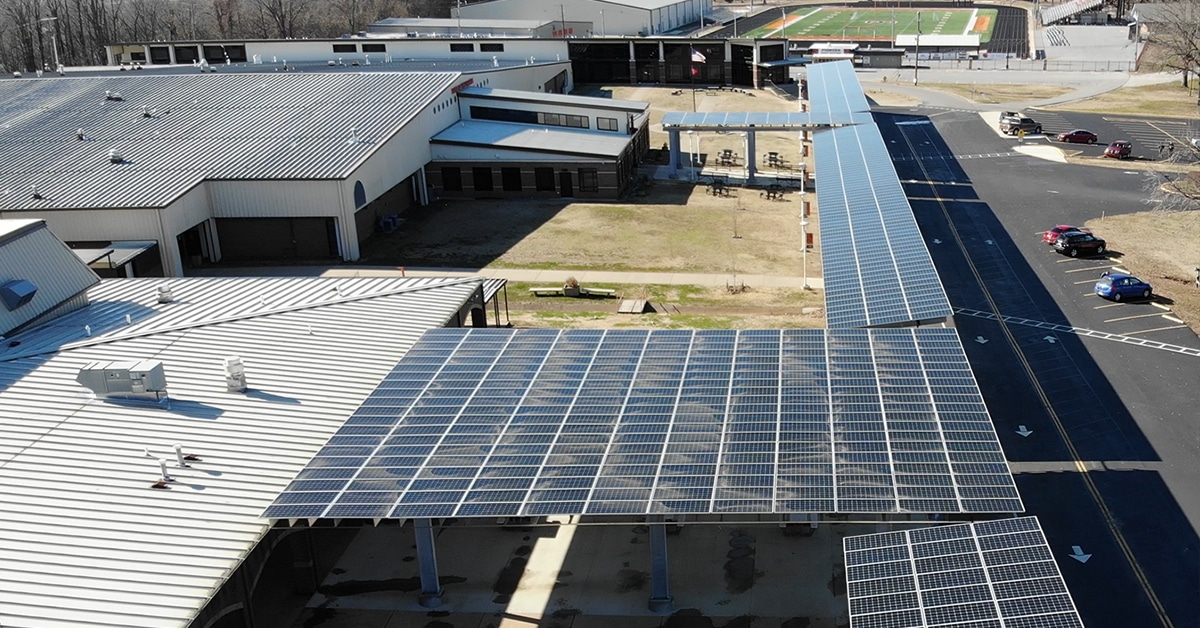This case study was originally published in the 3rd edition of Brighter Future: A Study on Solar in U.S. Schools (2020)
In 2017, Dr. Michael Hester became the superintendent of the Batesville School District. At the time, the district was underfunded by $250,000. His district paid the lowest teacher salaries out of the five districts in Independence County, Arkansas, and he was losing great teachers because of the low pay. He knew he couldn’t serve his students well unless he could retain their best educators.
After an initial energy audit showed that the district was paying over $600,000 annually in utilities, he sought to cut energy and water costs to eliminate the budget deficit instead of shuttering schools or laying off teachers. The district partnered with energy services company Entegrity to install 759 kW of solar on two campuses along with upgrades in lighting, energy efficiency and water efficiency. Through an energy service performance contract (ESPC), Entegrity guarantees that the energy and operational savings will pay for the project costs each year and generate additional savings.

Currently the largest solar installation in any school district in Arkansas, Batesville’s 1,483 solar panels generate about half of the district’s electricity needs and provide a savings of nearly $100,000 per year.
The teachers were also asked to contribute to the savings by conserving energy in the buildings. In exchange, they’d get pay raises. Hester told his staff, “We have to go into footprint reduction and efficiency mode. If you do this with us, we will get you the money back with raises that will attract and retain staff.”
Teachers were also trained on how to incorporate solar technology into the curriculum as part of students’ STEM learning.
The district has reduced its energy consumption by 1.6 million kWh per year and expects a net savings of over $4 million over 20 years from the solar energy generation, energy conservation and water efficiency upgrades. A portion of the energy savings is going back to the teachers as pay raises averaging $2,000 to $3,000 per year and up to $9,000 per year for some long-time employees.
Thanks to this project and other strategic cost reductions, the district went from a $250,000 budget deficit to a $1.8 million surplus within three years. Now the district ranks first in teacher pay out of the five districts in the county. According to Dr. Hester, “Putting money into staff is the best way to put students first.”
A portion of the energy savings is going back to the teachers as pay raises averaging $2,000 to $3,000 per year and up to $9,000 per year for some long-time employees.
According to the superintendent, the most surprising part about the project was the positive response from the community, which is situated in the backyard of the largest coal-fired power plant in the state. Community members drive up to the school to see the long solar canopy that frames the front of the high school now. They are happy to see that the school district has been a good steward of their tax dollars.
The neighboring school districts have also taken notice. Entegrity reports that there are 20 school districts surrounding Batesville that are interested in going solar and achieving the same savings and added benefits.
Staying true to the spirit of his district’s mascot, the Pioneers, Superintendent Hester is continuing to explore new frontiers with clean energy. He already is planning his next solar project and aims to be the first net zero energy school district in the state.
Thanks to newly passed legislation that expanded the solar energy system size allowed per customer and enabled third-party ownership, Batesville School District plans to sign a solar service agreement with Entegrity to add 757 kW of solar at an offsite location with no upfront or ongoing maintenance costs.
Our goal is to be net zero on utilities, which would mean paying nothing for utilities. Those savings can go to salaries and staff.
Dr. Michael Hester















